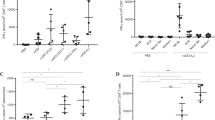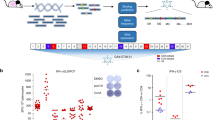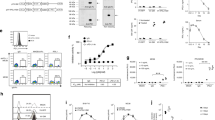Abstract
Our goal in the present study was to evaluate antitumor effects and frequency of tumor-infiltrating immune cells upon intratumoral injection of RGD fiber-mutant adenoviral vector (AdRGD) encoding the chemokines CCL17, CCL19, CCL20, CCL21, CCL22, CCL27, XCL1, and CX3CL1. Among eight kinds of chemokine-expressing AdRGDs, AdRGD-CCL19 injection most efficiently induced infiltration of T cells into established B16BL6 tumor parenchyma, whereas most of these T cells were perforin-negative in immunohistochemical analysis. Additionally, the growth of AdRGD-CCL19-injected tumors decreased only slightly as well as that of other tumors treated with each chemokine-expressing AdRGD, which indicated that accumulation of naive T cells in tumor tissue does not effectively damage the tumor cells. Tumor-bearing mice, in which B16BL6-specific T cells were elicited by dendritic cell-based immunization, demonstrated that intratumoral injection of AdRGD-CCL17, -CCL22, or -CCL27 could considerably suppress tumor growth and attract activated T cells. On the other hand, AdRGD-CCL19-injection in the immunized mice showed slight increase of tumor-infiltrating T cells compared to treatment using control vector. Collectively, although AdRGD-mediated chemokine gene transduction into established tumors would be very useful for augmentation of tumor-infiltrating immune cells, a combinational treatment that can systemically induce tumor-specific effector T cells is necessary for satisfactory antitumor efficacy.
This is a preview of subscription content, access via your institution
Access options
Subscribe to this journal
Receive 12 print issues and online access
$259.00 per year
only $21.58 per issue
Buy this article
- Purchase on Springer Link
- Instant access to full article PDF
Prices may be subject to local taxes which are calculated during checkout








Similar content being viewed by others
Abbreviations
- AdRGD:
-
RGD fiber-mutant adenoviral vector
- CTL:
-
cytotoxic T lymphocyte
- DC:
-
dendritic cell
- FBS:
-
fetal bovine serum
- HE:
-
hematoxylin and eosin
- IFN:
-
interferon
- mAb:
-
monoclonal antibody
- NK:
-
natural killer
- PBS:
-
phosphate-buffered saline
- PFU:
-
plaque-forming unit
- RT-PCR:
-
reverse transcription-polymerase chain reaction
- TAA:
-
tumor-associated antigen
- Th:
-
helper T cell
References
Urban JL, Schreiber H . Tumor antigens. Annu Rev Immunol 1992; 10: 617–644.
Mackensen A, Carcelain G, Viel S, Raynal MC, Michalaki H, Triebel F et al. Direct evidence to support the immunosurveillance concept in a human regressive melanoma. J Clin Invest 1994; 93: 1397–1402.
Smyth MJ, Godfrey DI, Trapani JA . A fresh look at tumor immunosurveillance and immunotherapy. Nat Immunol 2001; 2: 293–299.
Tada T, Ohzeki S, Utsumi K, Takiuchi H, Muramatsu M, Li XF et al. Transforming growth factor-β-induced inhibition of T cell function. Susceptibility difference in T cells of various phenotypes and functions and its relevance to immunosuppression in the tumor-bearing state. J Immunol 1991; 146: 1077–1082.
Ohm JE, Carbone DP . VEGF as a mediator of tumor-associated immunodeficiency. Immunol Res 2001; 23: 263–272.
Jacobs SK, Wilson DJ, Kornblith PL, Grimm EA . Interleukin-2 or autologous lymphokine-activated killer cell treatment of malignant glioma: phase I trial. Cancer Res 1986; 46: 2101–2104.
Rosenberg SA, Yannelli JR, Yang JC, Topalian SL, Schwartzentruber DJ, Weber JS et al. Treatment of patients with metastatic melanoma with autologous tumor-infiltrating lymphocytes and interleukin 2. J Natl Cancer Inst 1994; 86: 1159–1166.
Mandelboim O, Vadai E, Fridkin M, Katz-Hillel A, Feldman M, Berke G et al. Regression of established murine carcinoma metastases following vaccination with tumour-associated antigen peptides. Nat Med 1995; 1: 1179–1183.
Conry RM, Curiel DT, Strong TV, Moore SE, Allen KO, Barlow DL et al. Safety and immunogenicity of a DNA vaccine encoding carcinoembryonic antigen and hepatitis B surface antigen in colorectal carcinoma patients. Clin Cancer Res 2002; 8: 2782–2787.
Dranoff G, Jaffee E, Lazenby A, Golumbek P, Levitsky H, Brose K et al. Vaccination with irradiated tumor cells engineered to secrete granulocyte-macrophage colony-stimulating factor stimulates potent, specific, and long-lasting anti-tumor immunity. Proc Natl Acad Sci USA 1993; 90: 3539–3543.
Asada H, Kishida T, Hirai H, Satoh E, Ohashi S, Takeuchi M et al. Significant antitumor effects obtained by autologous tumor cell vaccine engineered to secrete interleukin (IL)-12 and IL-18 by means of the EBV/lipoplex. Mol Ther 2002; 5: 609–616.
Mayordomo JI, Zorina T, Storkus WJ, Zitvogel L, Celluzzi C, Falo LD et al. Bone marrow-derived dendritic cells pulsed with synthetic tumour peptides elicit protective and therapeutic antitumour immunity. Nat Med 1995; 1: 1297–1302.
Song W, Kong HL, Carpenter H, Torii H, Granstein R, Rafii S et al. Dendritic cells genetically modified with an adenovirus vector encoding the cDNA for a model antigen induce protective and therapeutic antitumor immunity. J Exp Med 1997; 186: 1247–1256.
Nair SK, Heiser A, Boczkowski D, Majumdar A, Naoe M, Lebkowski JS et al. Induction of cytotoxic T cell responses and tumor immunity against unrelated tumors using telomerase reverse transcriptase RNA transfected dendritic cells. Nat Med 2000; 6: 1011–1017.
Yoshie O, Imai T, Nomiyama H . Chemokines in immunity. Adv Immunol 2001; 78: 57–110.
Zlotnik A, Yoshie O . Chemokines: a new classification system and their role in immunity. Immunity 2000; 12: 121–127.
Murphy PM . The molecular biology of leukocyte chemoattractant receptors. Annu Rev Immunol 1994; 12: 593–633.
Bokoch GM . Chemoattractant signaling and leukocyte activation. Blood 1995; 86: 1649–1660.
Homey B, Muller A, Zlotnik A . Chemokines: agents for the immunotherapy of cancer? Nat Rev Immunol 2002; 2: 175–184.
Sharma S, Stolina M, Luo J, Strieter RM, Burdick M, Zhu LX et al. Secondary lymphoid tissue chemokine mediates T cell-dependent antitumor responses in vivo. J Immunol 2000; 164: 4558–4563.
Fushimi T, Kojima A, Moore MA, Crystal RG . Macrophage inflammatory protein 3α transgene attracts dendritic cells to established murine tumors and suppresses tumor growth. J Clin Invest 2000; 105: 1383–1393.
Braun SE, Chen K, Foster RG, Kim CH, Hromas R, Kaplan MH et al. The CC chemokine CKβ-11/MIP-3β/ELC/Exodus 3 mediates tumor rejection of murine breast cancer cells through NK cells. J Immunol 2000; 164: 4025–4031.
Miyata T, Yamamoto S, Sakamoto K, Morishita R, Kaneda Y . Novel immunotherapy for peritoneal dissemination of murine colon cancer with macrophage inflammatory protein-1β mediated by a tumor-specific vector, HVJ cationic liposomes. Cancer Gene Ther 2001; 8: 852–860.
Guo J, Zhang M, Wang B, Yuan Z, Guo Z, Chen T et al. Fractalkine transgene induces T-cell-dependent antitumor immunity through chemoattraction and activation of dendritic cells. Int J Cancer 2003; 103: 212–220.
Gao J-Q, Tsuda Y, Katayama K, Nakayama T, Hatanaka Y, Tani Y et al. Antitumor effect by interleukin-11 receptor α-locus chemokine/CCL27, introduced into tumor cells through a recombinant adenovirus vector. Cancer Res 2003; 63: 4420–4425.
Okada N, Gao J-Q, Sasaki A, Niwa M, Okada Y, Nakayama T et al. Anti-tumor activity of chemokine is affected by both kinds of tumors and the activation state of the host's immune system: implications for chemokine-based cancer immunotherapy. Biochem Biophys Res Commun 2004; 317: 68–76.
Mizuguchi H, Koizumi N, Hosono T, Utoguchi N, Watanabe Y, Kay MA et al. A simplified system for constructing recombinant adenoviral vectors containing heterologous peptides in the HI loop of their fiber knob. Gene Therapy 2001; 8: 730–735.
Okada N, Masunaga Y, Okada Y, Iiyama S, Mori N, Tsuda T et al. Gene transduction efficiency and maturation status in mouse bone marrow-derived dendritic cells infected with conventional or RGD fiber-mutant adenovirus vectors. Cancer Gene Ther 2003; 10: 421–431.
Mizuguchi H, Kay MA . Efficient construction of a recombinant adenovirus vector by an improved in vitro ligation method. Hum Gene Ther 1998; 9: 2577–2583.
Mizuguchi H, Kay MA . A simple method for constructing E1- and E1/E4-deleted recombinant adenoviral vectors. Hum Gene Ther 1999; 10: 2013–2017.
Lutz MB, Kukutsch N, Ogilvie AL, Rossner S, Koch F, Romani N et al. An advanced culture method for generating large quantities of highly pure dendritic cells from mouse bone marrow. J Immunol Methods 1999; 223: 77–92.
Okada N, Tsujino M, Hagiwara Y, Tada A, Tamura Y, Mori K et al. Administration route-dependent vaccine efficiency of murine dendritic cells pulsed with antigens. Br J Cancer 2001; 84: 1564–1570.
Okada N, Masunaga Y, Okada Y, Mizuguchi H, Iiyama S, Mori N et al. Dendritic cells transduced with gp100 gene by RGD fiber-mutant adenovirus vectors are highly efficacious in generating anti-B16BL6 melanoma immunity in mice. Gene Therapy 2003; 10: 1891–1902.
Eerola AK, Soini Y, Paakko P . A high number of tumor-infiltrating lymphocytes are associated with a small tumor size, low tumor stage, and a favorable prognosis in operated small cell lung carcinoma. Clin Cancer Res 2000; 6: 1875–1881.
Yin XY, Lu MD, Lai YR, Liang LJ, Huang JF . Prognostic significances of tumor-infiltrating S-100 positive dendritic cells and lymphocytes in patients with hepatocellular carcinoma. Hepatogastroenterology 2003; 50: 1281–1284.
Fukunaga A, Miyamoto M, Cho Y, Murakami S, Kawarada Y, Oshikiri T et al. CD8+ tumor-infiltrating lymphocytes together with CD4+ tumor-infiltrating lymphocytes and dendritic cells improve the prognosis of patients with pancreatic adenocarcinoma. Pancreas 2004; 28: e26–e31.
Naito Y, Saito K, Shiiba K, Ohuchi A, Saigenji K, Nagura H et al. CD8+ T cells infiltrated within cancer cell nests as a prognostic factor in human colorectal cancer. Cancer Res 1998; 58: 3491–3494.
Shankaran V, Ikeda H, Bruce AT, White JM, Swanson PE, Old LJ et al. IFN-γ and lymphocytes prevent primary tumour development and shape tumour immunogenicity. Nature 2001; 410: 1107–1111.
Zhang L, Conejo-Garcia JR, Katsaros D, Gimotty PA, Massobrio M, Regnani G et al. Intratumoral T cells, recurrence, and survival in epithelial ovarian cancer. N Engl J Med 2003; 348: 203–213.
Smolle J, Hofmann-Wellenhof R, Fink-Puches R . Melanoma and stroma: an interaction of biological and prognostic importance. Semin Cutan Med Surg 1996; 15: 326–335.
Luther SA, Bidgol A, Hargreaves DC, Schmidt A, Xu Y, Paniyadi J et al. Differing activities of homeostatic chemokines CCL19, CCL21, and CXCL12 in lymphocyte and dendritic cell recruitment and lymphoid neogenesis. J Immunol 2002; 169: 424–433.
Crittenden M, Gough M, Harrington K, Olivier K, Thompson J, Vile RG . Expression of inflammatory chemokines combined with local tumor destruction enhances tumor regression and long-term immunity. Cancer Res 2003; 63: 5505–5512.
Okada N, Tsukada Y, Nakagawa S, Mizuguchi H, Mori K, Saito T et al. Efficient gene delivery into dendritic cells by fiber-mutant adenovirus vectors. Biochem Biophys Res Commun 2001; 282: 173–179.
Okada N, Saito T, Masunaga Y, Tsukada Y, Nakagawa S, Mizuguchi H et al. Efficient antigen gene transduction using Arg-Gly-Asp fiber-mutant adenovirus vectors can potentiate antitumor vaccine efficacy and maturation of murine dendritic cells. Cancer Res 2001; 61: 7913–7919.
Moser B, Loetscher P . Lymphocyte traffic control by chemokines. Nat Immunol 2001; 2: 123–128.
Kim CH, Nagata K, Butcher EC . Dendritic cells support sequential reprogramming of chemoattractant receptor profiles during naive to effector T cell differentiation. J Immunol 2003; 171: 152–158.
Mullins IM, Slingluff CL, Lee JK, Garbee CF, Shu J, Anderson SG et al. CXC chemokine receptor 3 expression by activated CD8+ T cells is associated with survival in melanoma patients with stage III disease. Cancer Res 2004; 64: 7697–7701.
Hudak S, Hagen M, Liu Y, Catron D, Oldham E, McEvoy LM et al. Immune surveillance and effector functions of CCR10+ skin homing T cells. J Immunol 2002; 169: 1189–1196.
Koizumi N, Mizuguchi H, Sakurai F, Yamaguchi T, Watanabe Y, Hayakawa T . Reduction of natural adenovirus tropism to mouse liver by fiber-shaft exchange in combination with both CAR- and αv integrin-binding ablation. J Virol 2003; 77: 13062–13072.
Okada Y, Okada N, Mizuguchi H, Hayakawa T, Nakagawa S, Mayumi T . Transcriptional targeting of RGD fiber-mutant adenovirus vectors can improve the safety of suicide gene therapy for murine melanoma. Cancer Gene Ther 2005; 12: 608–616.
Acknowledgements
We are grateful to Drs Osamu Yoshie and Takashi Nakayama (Department of Microbiology, Kinki University School of Medicine, Osaka-Sayama, Japan) for providing plasmids containing murine chemokine cDNA, to Yoshinobu Kimura (Department of Biopharmaceutics, Kyoto Pharmaceutical University, Kyoto, Japan) for technical assistance, and to KIRIN Brewery Co., Ltd (Tokyo, Japan) for providing recombinant murine granulocyte/macrophage colony-stimulating factor. The present study was supported in part by the Research on Health Sciences focusing on Drug Innovation from The Japan Health Sciences Foundation; by grants from the Bioventure Development Program of the Ministry of Education, Culture, Sports, Science and Technology of Japan, and by grants from the Ministry of Health, Labour and Welfare in Japan.
Author information
Authors and Affiliations
Corresponding author
Rights and permissions
About this article
Cite this article
Okada, N., Sasaki, A., Niwa, M. et al. Tumor suppressive efficacy through augmentation of tumor-infiltrating immune cells by intratumoral injection of chemokine-expressing adenoviral vector. Cancer Gene Ther 13, 393–405 (2006). https://doi.org/10.1038/sj.cgt.7700903
Received:
Revised:
Accepted:
Published:
Issue Date:
DOI: https://doi.org/10.1038/sj.cgt.7700903
Keywords
This article is cited by
-
Integration of single-cell sequencing and bulk expression data reveals chemokine signaling pathway in proliferating cells is associated with the survival outcome of osteosarcoma
BMC Medical Genomics (2023)
-
Exploiting innate immunity for cancer immunotherapy
Molecular Cancer (2023)
-
CircTMC5 promotes gastric cancer progression and metastasis by targeting miR-361-3p/RABL6
Gastric Cancer (2022)
-
HCT-116 colorectal cancer cells secrete chemokines which induce chemoattraction and intracellular calcium mobilization in NK92 cells
Cancer Immunology, Immunotherapy (2019)
-
Increases in Serum TARC/CCL17 Levels Are Associated with Progression-Free Survival in Advanced Melanoma Patients in Response to Dendritic Cell-Based Immunotherapy
Journal of Clinical Immunology (2009)



